Executive Summary
Tax reform is likely to become a key issue on both the individual and corporate sides in 2017. President Donald Trump released a plan that called for significant changes on both levels. Congress anticipates taking up the issue once health care and budgeting have cleared the deck.
Americans see a great need to update the tax system. A majority support minor or even major reforms. However, reform on the individual side motivates Americans’ political behavior far more than reform on the business side. Moreover, Americans have differing ideas of what reform should look like, and even the ultimate goal of tax policy as a whole, which hints at the potential for opposition from those who place high importance on reforms in the direction of higher rather than lower rates.
Perhaps a greater challenge, however, is the prevalent misinformation and misperception about the current tax burden, especially that borne by American businesses. A sense of unfairness and concern that corporations get away with not paying their fair share is propped up by an underlying belief that the corporate tax rate is significantly lower than it truly is.
Educating Americans on the true combined federal and state business rate of 39 percent can help in building support for lower rates, as can comparison to other similar countries’ rates. Every country in the developed world has rates lower than those of the U.S. When Americans know these facts, a majority support reducing the rate to make it more competitive.
Showing the impact of high rates on everyday Americans can also build support for a lower, more competitive corporate tax rate. Although divided on the specifics of tax policy, Americans are united in the concern that reduced corporate tax rates benefit workers and consumers through job creation and low prices. Emphasizing these themes and educating Americans on the actual rates that currently burden businesses can help unite opinion on and build support for a lower, more competitive rate.
Methodology
The American Perceptions Initiative (API), a project of The Heritage Foundation, conducted a market research study of voters’ familiarity, attitude, and perspectives on corporate tax reform. The market research also gauged their level of support and agreement with related messages and communications.
The American Perceptions Initiative’s research is conducted in partnership with Vision Critical, Maru, and Heart+Mind Strategies, and is fielded online with the Springboard America platform.
The research specialists at Vision Critical help their commercial, government, media, and not-for-profit clients better understand their customers and stakeholders, covering subjects including public opinion, health, technology, consumer goods, media, and travel.
Maru is an affiliated company incorporating the Springboard America platform, a high-quality panel of over 300,000 U.S. panelists.
Heart+Mind Strategies is an experienced consulting firm specializing in winning the hearts and minds of the people that matter most to their clients’ success.
The American Perceptions Initiative’s study on corporate tax reform was conducted online from March 17–27, 2017, among 1,017 registered voters. A probability sample of the same size would have a margin of error of ±3.1 percent.
Part I: The Landscape of Corporate Tax Reform
Hunger for Reform
Americans are united in their desire to see significant tax reform as in few other issues in this polarized political climate. The vast majority of Americans believe the federal tax system needs some change. Sixty-four percent believe it needs major changes and reform. Nine percent think it is working well in its present form. Although the desire for major reform is strongest among Republicans (71 percent), majorities of both Independents (67 percent) and Democrats (55 percent) also believe major change is needed.
Beyond the simple desire for change, the details of tax reform are more complex. When given a list of potential issues that could motivate their political action, Americans put individual income tax reform at the top of the list (76 percent, very/one of the most influential)—just behind health care. Corporate tax reform fell at the bottom (40 percent). While Americans are eager for changes to the part of the tax system that impact them most directly—income tax—they have less concern or even awareness over the business side of the equation.
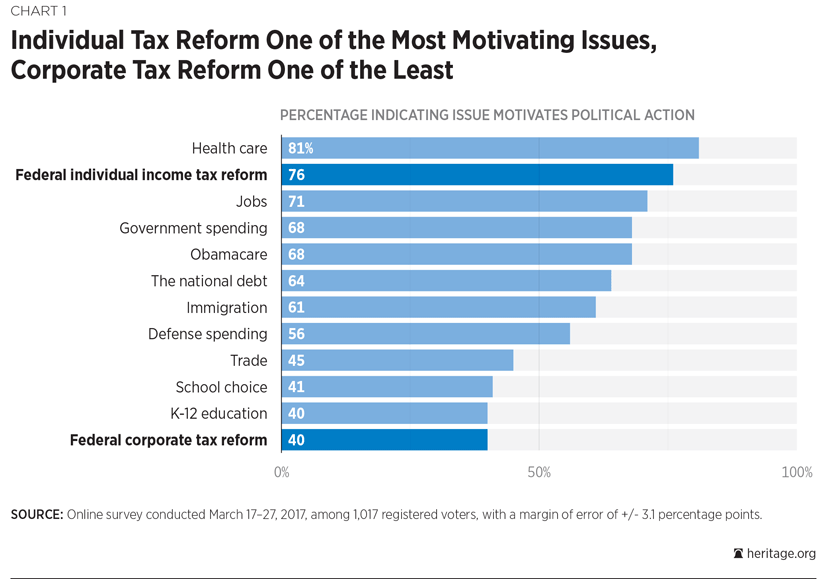
Both types of reform are more important to Democrats, with 83 percent motivated by income tax reform and 46 percent motivated by corporate tax reform as an issue, than Republicans (71 percent and 35 percent, respectively) and Independents (72 percent and 37 percent, respectively), even though Democrats are less likely to believe changes are needed. Vague or general references to tax reform, being more salient to Democrats, may reinforce more liberal notions of reform.
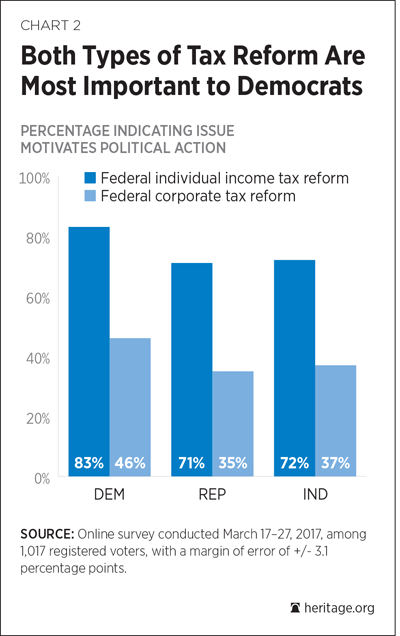
Indeed, there are some noticeable differences between how those of different political parties think about tax policy. For all Americans, “stimulating investment and economic growth” was considered the top goal of tax policy. However, while Republicans and Independents view paying for government as the second goal, Democrats consider redistributing wealth to fight income inequality equally important to stimulating growth, and more important than paying for government services.
All Americans are united in wanting reform, but their ideas of what reform will look like and what goals should shape it differ. However, most are motivated by stimulating economic growth.
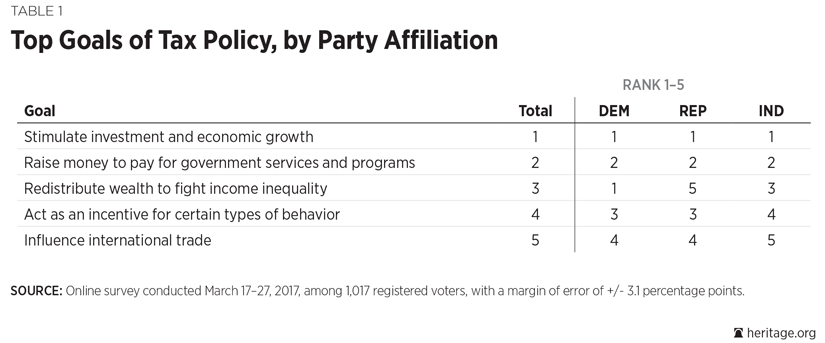
Corporate Tax Rates: Uncompetitive and Too High
Although corporate tax reform may not be high on the public’s agenda, it has an unquestionable impact on the economy and prosperity of all Americans. Already figuring prominently in President Trump’s broader tax proposal, it is also likely to be a key feature in tax reform debates on Capitol Hill.
In anticipation of the issue heating up in 2017, a number of public opinion outlets have begun exploring the issue, usually reporting that Americans have one major complaint: the wealthy and corporations pay too little.
An April 2017 poll by Pew Research Center, conducted shortly before the release of the President’s tax plan, found that: 54 percent say they pay the right amount in taxes; 27 percent are bothered “a lot” by the amount they pay in taxes; 60 percent are bothered “a lot” that wealthy people do not pay their fair share; and 62 percent are bothered “a lot” that some corporations do not pay their fair share.
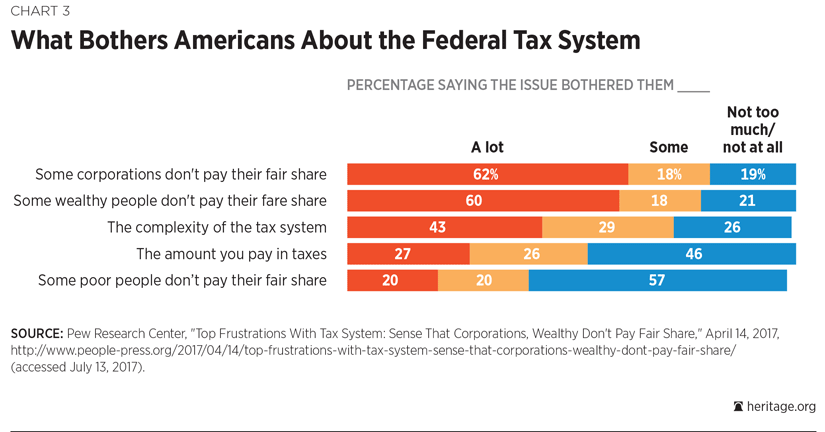
At the same time, Americans are increasingly saying that the federal tax system is unfair: 56 percent not too/not at all fair, up from 48 percent in 2015.[REF]
The attitude is most prevalent among Democrats, with 75 percent bothered a lot. However, 40 percent of Republicans also agree. Americans are more unified in their lesser concerns over the complexity of the tax system (39 percent Democrat and 49 percent Republican), the amount they pay in taxes (21 percent Democrat and 35 percent Republican), and that some poor people do not pay their fair share (15 percent Democrat and 26 percent Republican).
A study conducted by Gallup around the same time found similar results. Sixty-three percent think upper-income people pay too little and 67 percent think corporations pay too little.
Concerns that middle-income Americans pay too much has risen since 2013, when 56 percent said they pay their fair share and only 36 percent thought they pay too much. Now, 51 percent think they pay too much.[REF]
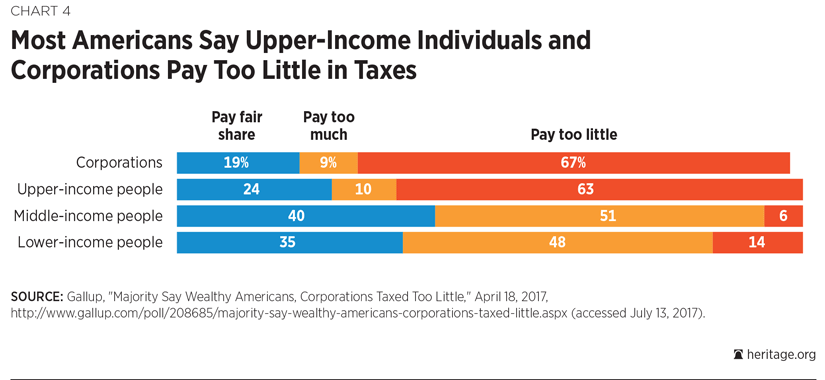
Americans may be assumed to be reasonably familiar with what they pay in taxes—if they look at their pay stubs or consider expected tax refunds or payments each April. However, few of these polls have explored Americans’ familiarity with what others pay and what perceptions are driving concerns over the wealthy and corporations.
Asking these questions reveals that Americans discontent with corporations is due more to unfamiliarity with the current tax system than reality. On average, Americans believe the combined federal and state corporate tax rate is 30 percent. The most common response when Americans guessed the corporate rate was 35 percent; however, many thought it was even lower—30 percent, 25 percent, 20 percent, and even 15 percent and 10 percent. In reality, the combined federal and state corporate tax rate is higher than they think at 39 percent.
When Americans learn that the combined state and federal tax rate is actually 39 percent, far from worrying that corporations are not paying enough, 50 percent of Americans believe that rate is too high. Furthermore, Americans are sensitive to the globally uncompetitive nature of the U.S. system. Hence, when they learn that the U.S. has the highest rate in the developed world, the proportion who believes the rate is too high climbs to 67 percent, while only 7 percent would still say it is too low.
The consensus that rates are too high translates into policy. Similar proportions—54 percent of those who just learned the correct rate and 62 percent of those who also learned of other countries’ rates—would support lowering the corporate tax rate. Of those that would reduce the rate, 38 percent support reducing it a lot. The majority (55 percent) would prefer to reduce it a little, most likely to a level that more closely fits with their original estimate.
Two-thirds (68 percent) would also support cutting corporate tax rates to “encourage businesses to stay in or come back to the U.S., bringing jobs and economic growth,” while only 32 percent would choose to not cut corporate tax rates for fears that it would lead to program cuts or greater wealth inequality. A similar proportion (64 percent) believe corporate tax cuts are affordable by eliminating other forms of corporate welfare and stimulating economic growth.
Democrats were evenly divided between the perspectives, while jobs and economic growth appealed strongly to Republicans and Independents. However, all three parties (73 percent) agree that corporations make decisions on what is best for them, and nations must make their land an attractive place for businesses if they want companies to do business there.
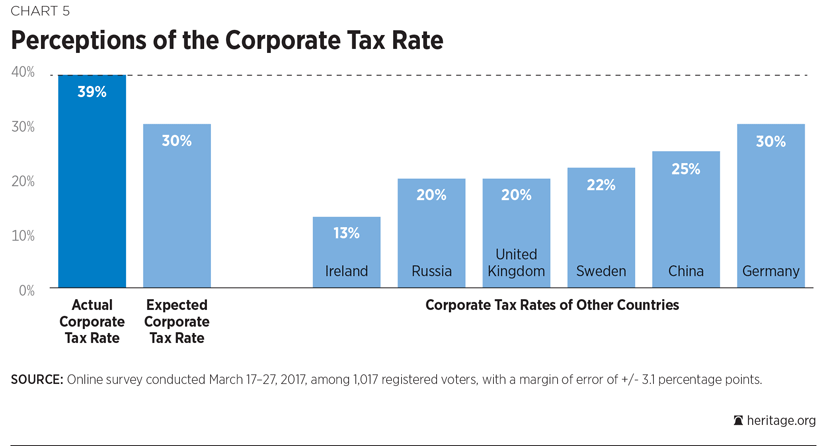
Top Motivators
Americans see promoting employment as the most important benefit of corporate tax reform, followed by improving economic growth and prosperity. Ensuring everyone pays their fair share comes in a close third, echoing themes noted by Gallup and Pew Research Center. What constitutes a “fair share” varies, and is arguably lower than the current rate according to most Americans.
Furthermore, rating promoting employment and economic growth as important benefits of corporate tax reform is correlated to support for reducing rates. Americans who see the strong connection between these three issues are more likely to see a need to reduce business tax rates.
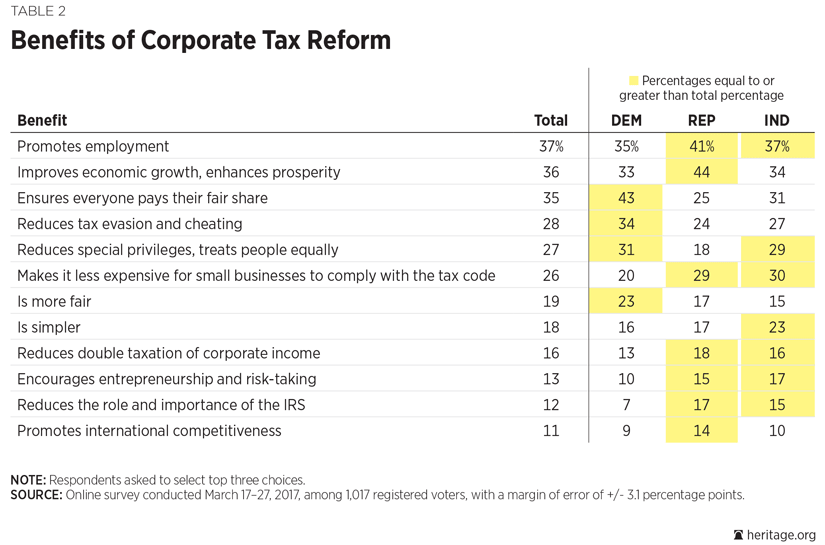
Americans believe corporate tax rates have a greater negative impact on workers and customers than on business owners or shareholders, who are the ones most directly impacted by those rates in reality. Americans rate the negative impact of federal corporate taxes on workers and consumers at approximately a 7 on a scale of 10, while they only rate the impact to business owners and shareholders at a 6.
Explaining how these groups are impacted does not significantly change the degree of impact Americans see. In fact, describing decreased profits for business owners slightly decreases the degree of negative impact Americans see. Overall, impact to workers through jobs and consumers through possible increases in prices, as well as everyday Americans through the overall economy, resonates most with Americans.
Part II: The Language of Corporate Tax Reform
Workers and Consumers
Themes of workers, consumers, and economic growth are equally apparent in the language that resonates with Americans. Out of a number of different groups, workers and consumers are the only ones viewed very positively, with equity scores of 54 and 45 respectively. Businesses and shareholders elicit a more tepid positive response at 29 and 25, and corporations are neutral.[REF]
Workers and consumers also formed the center for messages drawing the highest agreement:
- “Consumers ultimately pay for corporate taxes through higher prices”: 87 percent agree.
- “Workers ultimately pay for corporate taxes through lower wages and lost jobs”: 78 percent agree.
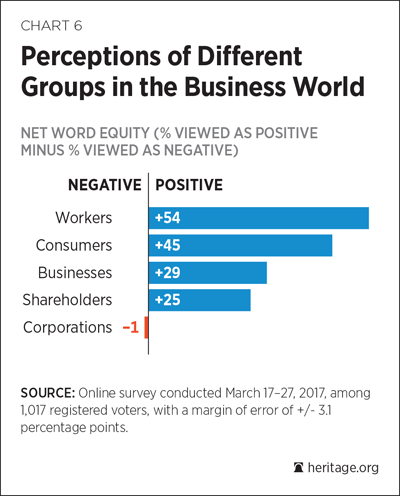
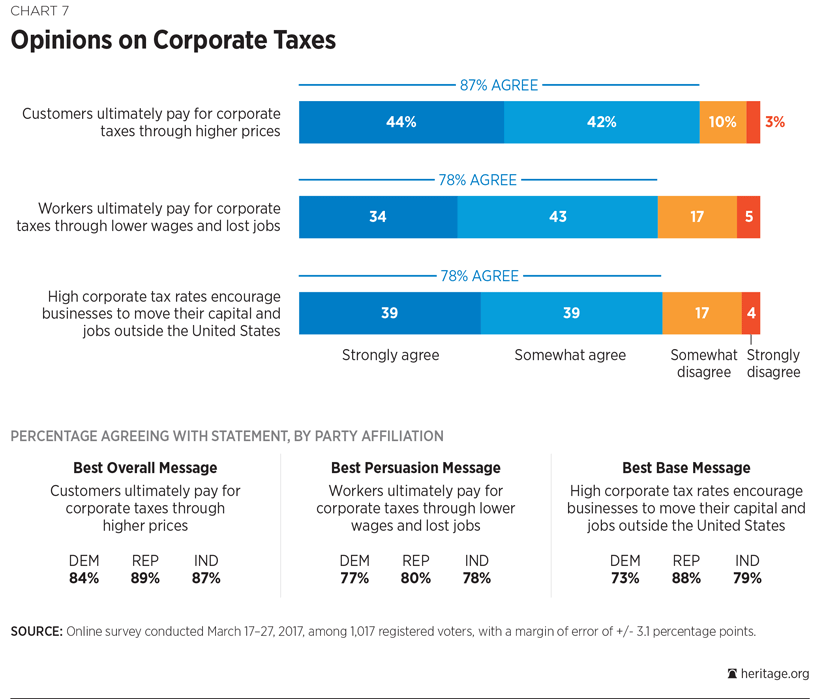
Of these two strong themes, the connection to higher prices for consumers is more widely recognized, with 9 percent more Americans agreeing, and more strongly felt. Forty-four percent of Americans strongly agree that consumers pay through higher prices, compared to only 34 percent who strongly agree that workers pay through lower wages and lost jobs. The American Perceptions Initiative has identified this as the best overall message for its strong and broad support.
Both messages receive strong agreement across party lines, indicating the power of these themes to unify, connect, and draw broad support from Americans. Messages emphasizing the impact to workers were most likely to appeal to those who did not initially support lowering the corporate tax rates, but may be persuaded to. Eighteen percent of Americans said that the corporate tax rate was just right or too low, despite learning what the actual rate was, and did not support lowering it, but later agreed that the U.S. should cut corporate tax rates “to encourage businesses to stay in or come back to the United States, bringing jobs and economic growth” over concerns that a reduction would lead to cuts to government programs and higher wealth concentration. Among that 18 percent, 83 percent agreed that workers are negatively impacted through high rates—a 5-point increase from the total. The American Perceptions Initiative has identified this as the best persuasive message for changing minds, where education on the actual rate and country comparisons fail to have an effect.
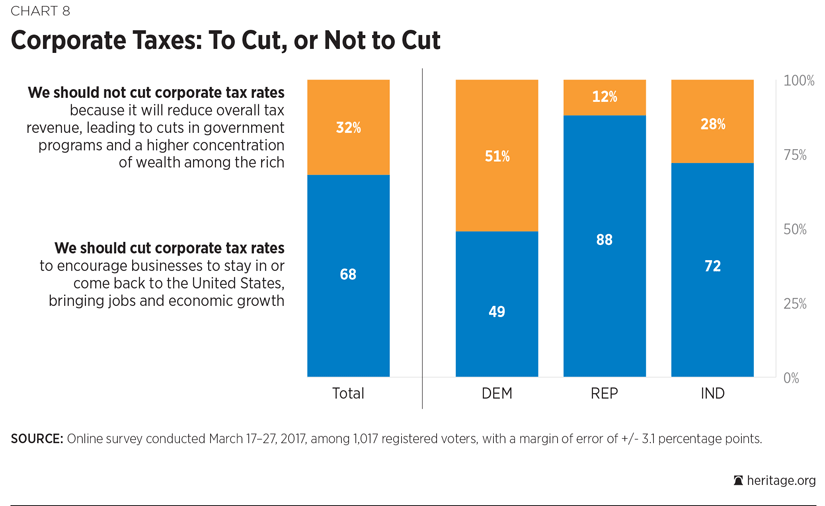
Global Economy and the Tax Code
Americans recognize the competitive nature of the global economy. Countries compete with one another for business that provides jobs and taxable income to bolster their economies and bring greater prosperity. Hearing the U.S. rate compared to other similar countries is convincing in part because of this reality. In fact, 68 percent say the U.S. should lower rates to encourage businesses to stay in or come back to the country, bringing jobs and economic growth, over maintaining the current rates to prevent program cuts and wealth concentration.
Moreover, Americans are aware that the economic conditions of a country profoundly affect a company’s decision about where to locate. Seventy-three percent agree that corporations made decisions based on what is best for them, and a country’s conditions should be made attractive to them to bring in business. Only 27 percent think that patriotic duty or loyalty will keep a company if it is profitable to operate elsewhere.
One of the highest messages tested tapped into this dynamic:
- “High corporate tax rates encourage businesses to move their capital and jobs outside of the United States”: 78 percent agree.
However, this message was slightly more polarizing than other top messages, with a 15 point gap between Republican agreement (88 percent) and Democratic agreement (73 percent), with Independents in between (79 percent).
The polarization is more pronounced when the practical results are explored, with lowering overall agreement as one result:
- “With the highest corporate tax rate among developed countries, the U.S. can’t compete with other countries for businesses and jobs”: 68 percent agree.
Agreement is slightly lower among even Republicans (79 percent), and Independents (71 percent). However, the partisan divide widens from 15 points to 19, with Democrats agreeing at only 60 percent.
While Americans may largely agree in theory that high rates encourage businesses to move offshore, the practical implications on the U.S.’s ability to compete in the world resonate more strongly among those on the right side of the political spectrum. The American Perceptions Initiative has designated this a strong base message, tapping into Republicans’ more globally competitive values.
Public Perception of Corporations
Corporations are made up of people—the workers, the shareholders, and the owners. Economists are quick to recognize that businesses are complex human ecosystems with immense impact on the American economy and prosperity. Americans are more likely to see them as cold, impersonal entities, at odds with everyday Americans and their prosperity rather than entwined with them.
Attempts to reveal the human side of corporations are met with strong opposition. Shareholders and owners, the human side of the corporation equation, meet with tepid responses. Shareholders elicited a 25 word equity score—positive but barely out of the neutral range. A message stressing the impact to these individuals, “Corporate taxes hurt business owners and shareholders by forcing them to give more of their profits to the government,” received 63 percent agreement, and of that 63 percent, only 23 percent agreed strongly. The shareholders message was one of the lowest messages tested, higher only than a pro-corporate tax message.
Removed from their context, some common taglines aimed at highlighting this aspect of corporations did poorly as well.
- “Corporations are people,” a phrase Mitt Romney used with disastrous effect in his presidential run, received a slightly negative equity score of –7.
- “People pay taxes, corporations do not” received an even more negative score of –33.
- The clearer “corporations are made up of people” did better at +30, but still only had a somewhat positive impact.
Those who would want to build support for lowering the corporate tax rate should focus on linking the effect of lower rates to already popular groups like workers and consumers rather than trying to humanize corporations against such opposition.
Part III: Special Issues in Corporate Tax Reform
Deductions, Credits, and Exclusions
Americans prefer eliminating most deductions, tax credits, and exclusions in exchange for lower rates (46 percent) to keeping them (26 percent) by almost two to one. However, more Americans say they are unsure which they would choose (28 percent) than would choose to keep them.
Calling these items “tax vs.” slightly increases support for elimination to 51 percent, while support for retaining them drops off significantly to 12 percent. However, the proportion of unsure rises to 37 percent, suggesting that “tax preferences” is an unfamiliar and unclear way of referring to deductions and credits.
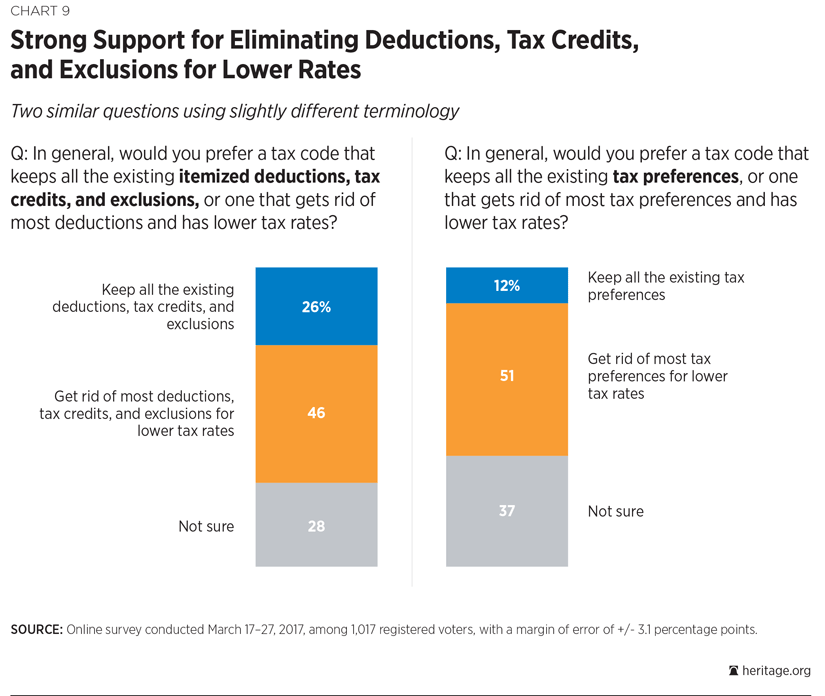
Double Taxation and Corporate Integration
Americans tend to oppose, albeit not strongly, double taxation of corporate earnings through corporate taxes and shareholders’ capital gains taxes, when explained. A little over half (54 percent) view it negatively, saying it is either not a very good approach (38 percent) or a terrible approach (16 percent). Just under half (46 percent) consider it a either a good approach (39 percent) or an excellent approach (7 percent). While the proportion of those who consider it a good approach and a not very good approach is nearly evenly split, those who consider it a terrible approach outweighs those who consider it an excellent approach more than two to one. The term itself elicits a somewhat negative reaction at –37 word equity.
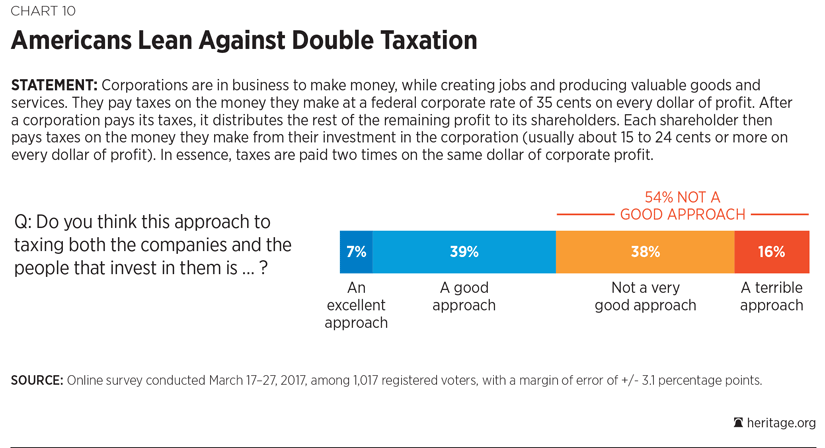
Americans are split (40 percent to 40 percent) on corporate integration—the elimination of taxes at the corporate level in favor of taxation of profit only on the individual level to prevent double taxation. The opposition has a slightly stronger tone (17 percent strongly oppose while 11 percent strongly support).
However, 20 percent of Americans are unsure about corporate integration, even after receiving an explanation of the proposal. Those that are unsure about corporate integration tend to be moderate in their overall attitudes towards tax reform, supporting minor changes more than major or no changes; somewhat rather than strongly supporting or opposing corporate tax rate reduction in equal numbers; and more likely to identify with no particular political party and no political ideology. The side of the debate that wins this audience will have the greater public opinion support.
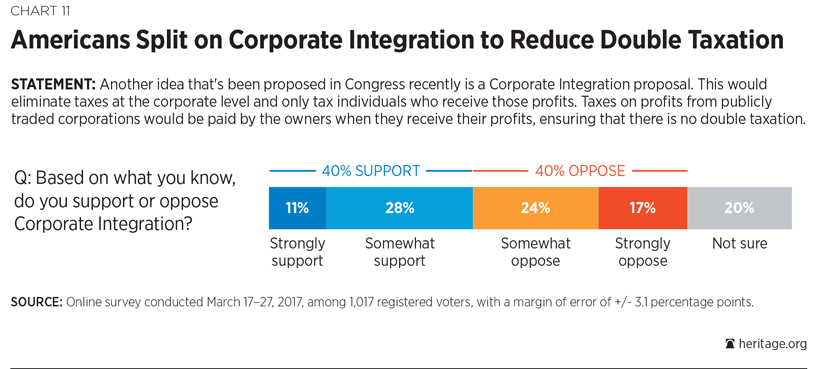
Dynamic Scoring
The media and lawmakers often tout Congressional Budget Office (CBO) scores of the impact of new laws to the existing federal budget as a sign of their feasibility. CBO scores are projections based off modeling the future impact of a proposed law. The models can be complex and differ in what and how they consider impact.
One possible variation on historic “static” modeling of tax reform policies involves dynamic scoring, adjusting the model to account for expected changes in the economy as a result of tax policy changes, which affect the income available to tax (among other considerations).
When dynamic scoring is explained, Americans tend to support using it in CBO scoring for tax reform, with 54 percent to 66 percent preferring it, depending on the explanation given. The clearest and most credible explanation tested was a simple one: “The cost of reducing tax rates may be offset by positive growth in the economy, which in turn generates more tax revenue for the government.” An even 66 percent supported this method.
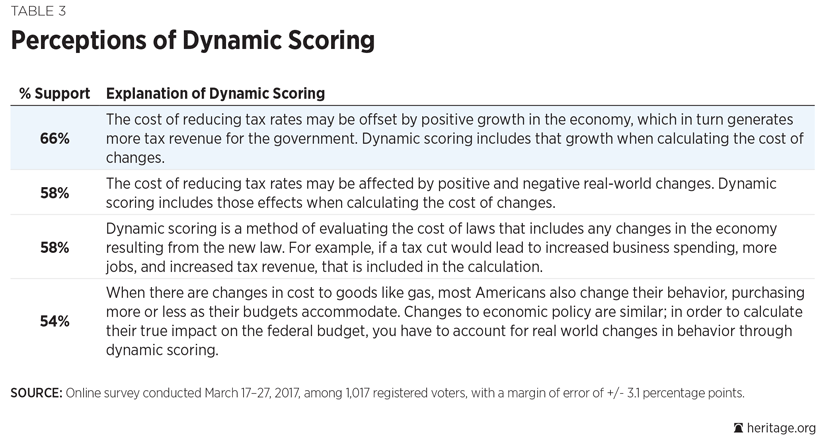
Border Tax Adjustment
When confronted with arguments for and against, Americans are split on the Border Adjustment Tax (BAT) as a measure that would tax goods imported to the U.S. while not taxing goods the U.S. exports to other countries.
Forty percent would oppose the BAT because it could have negative economic impact, increasing the price of imports and decreasing trade.
Thirty-six percent would support it as a way of raising revenue to support other business tax reforms.
Twenty-four percent were neutral or unsure, even having received a description.
Revenue Neutrality
Without hearing any description, 70 percent of Americans agree that reduction in corporate tax rates should be “revenue neutral”. Agreement is tepid and likely uncertain, with 51 percent saying they only somewhat agree, and just 19 percent strongly agreeing.
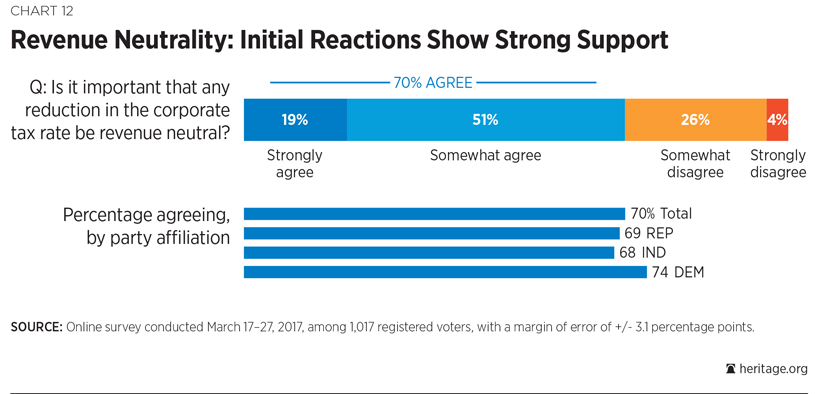
However, when asked to choose between two perspectives on revenue neutrality, the percentage who agree that all changes to the tax code should be revenue neutral dips to 55 percent. Opposition to revenue neutrality grew by 15 points, with 45 percent agreeing with the perspective that revenue neutrality is a trap because it requires one man’s tax cut to be offset by another’s increase, keeping the tax burden on Americans and the economy the same.
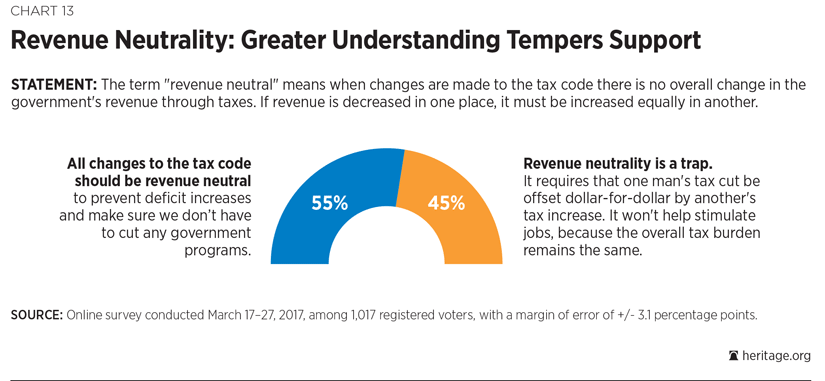
When given practical options of how to respond to the potential for lower federal income, support for revenue neutral measures drops further. Nearly half of Americans think tax cuts should be paid for through overall spending cuts (49 percent), while 23 percent think they should be made up in other taxes (23 percent). Another 19 percent think cuts should come specifically from entitlement reform to reduce the burden of the largest federal programs. Only 8 percent think tax cuts should lead to a higher deficit and more national debt.
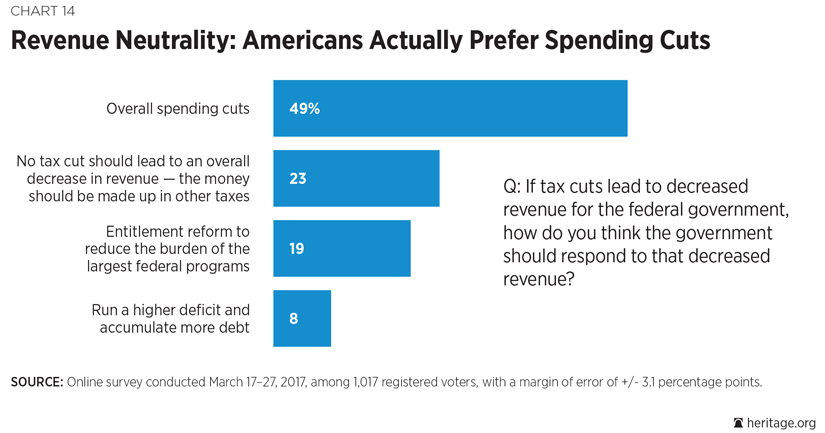
Conclusion
Americans see a strong need to update the tax system with minor or even major reforms. However, most Americans think more of reform on the individual side than the business side. Moreover, Americans hold differing ideas of what reform should look like, and even the ultimate goal of tax policy as a whole.
Although divided on specifics, Americans are united in their concern that corporate tax rates be competitive in the global economy and benefit workers and consumers domestically through job creation and low prices. Emphasizing these themes and educating Americans on the actual rates that currently burden businesses can help unify and build support for lower, more competitive rates.



